Asus ROG Ally review: 'a stealthy powerhouse'

On paper, the Asus ROG Ally is poised to hurl the Steam Deck from its throne. With a more powerful spec sheet and the ability to dive into any launcher you choose without jumping through hoops, the win was all but secured for the Ally on announcement. After just over a week with the device in hand, it's obvious this victory isn't going to be quite so easy.
The Asus ROG Ally has a difficult job on its hands. Squeezing a full gaming PC into a handheld form factor is a tall order for anyone, but Asus has years of producing some of the best gaming laptops on the market - if anyone can take a crack at the next portable PC they can.
Coming in at $699 / £699, the 512GB Z1 Extreme version (there's a cheaper, slightly weaker model in the works as well) already beats out the vast majority of portable PCs out there. On top of that, it's only $50 more than the top-end Steam Deck. If you're a console player looking to make the most of a far wider PC catalogue without buying a full rig, the Ally could be your best friend. I spent just over a week tinkering with the latest gaming handheld to see just how well it delivers on its lofty promises.
Design
Solid form factor inspires confidence in a premium product
Clean white aesthetic looks great
Excellent ergonomic form factor and balanced weight
The first time I held the Asus ROG Ally in my hands, it was clear this device was built to offer a solid, rugged feel without the weight of a more cumbersome device. The two angled curves running along the back cup the hands perfectly, while the sloping corners on the front make a particularly comfortable landing spot for the palms. There's just the right amount of chunkiness here - you know you're holding a stack of tech, but the form factor and weight allow for long-lasting comfort in a variety of sitting positions.
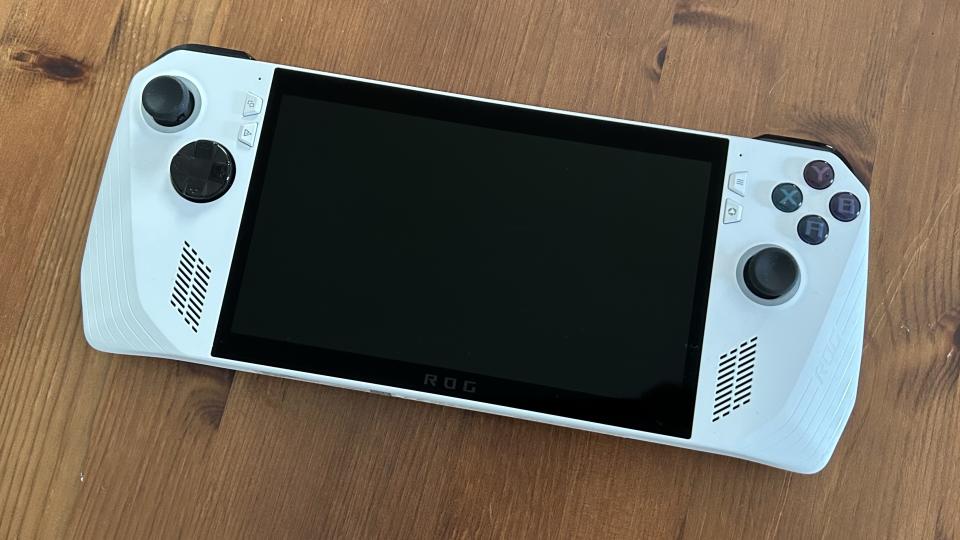
Pair that with a stark white aesthetic courtesy of the reinforced polycarbonate chassis, and gorgeous display and the ROG Ally screams pedigree. Despite the grey ROG logo on the lower bezel of the screen, you'd be hard pressed to identify the Ally as an Asus product from the front. Around the back, however, this lineage is boldly clear. From the reflective metallic strip slicing the back panel diagonally to the ridged texture and grills forming the classic ROG logo, it's a packed design but one that still doesn't crowd the experience. I'd be hesitant to call it subtle, but it certainly doesn't come out the gate screaming RGB and fans. The whole device feels like it's from the future, but a future that's easily within reach of today.
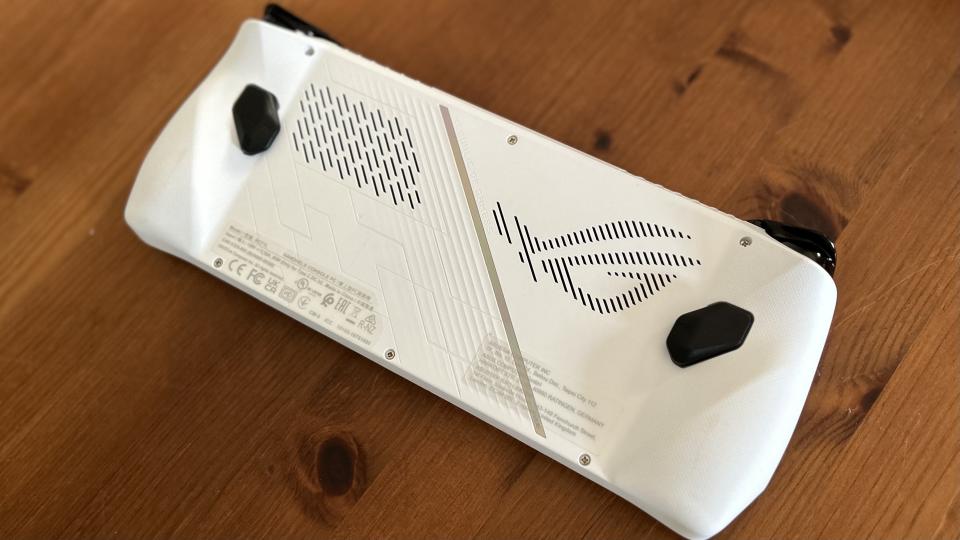
All of that sits in an 27.9 x 11.1 x 1.2 cm body and weighs in at 608g. Not only is that remarkably compact for the power housed inside (the Steam Deck comes in slightly wider and taller, and much thicker), but the weight is both low and well balanced. I was able to easily hold the device with one hand while shifting positions and maintain comfort over longer sessions as well.
There's no grip across the two thumbsticks adorning each side (instead they sport a precision-focused concave shape), but the textured diamond shape running across the back of each side makes for a particularly secure fit. Both the bumpers and triggers are coated in a similar texture, while the sloped sides around the front offer a wide ridged surface to keep everything in place as well.
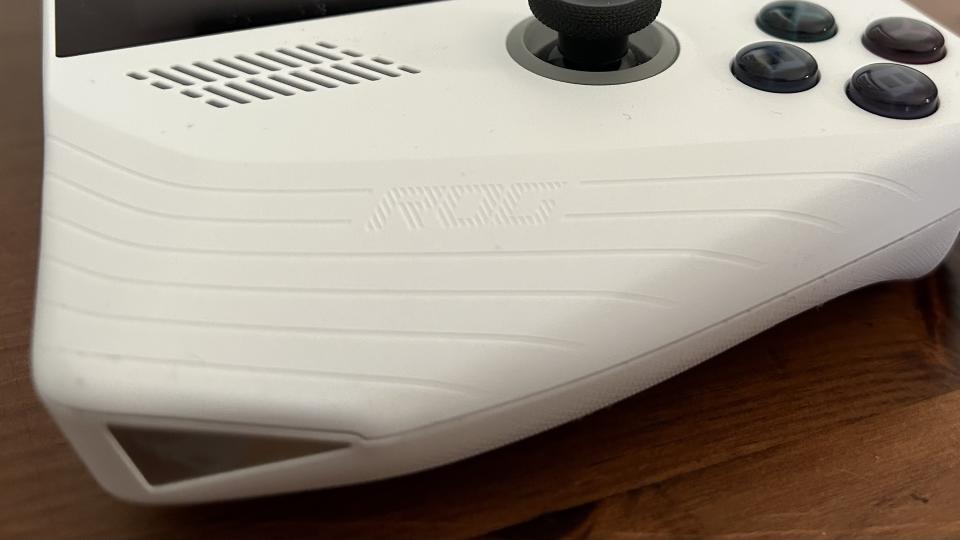
And then we get to the screen. On first booting the ROG Ally up, the larger bezels are going to make themselves known. I feared for a letterbox feel here, with a giant device crowding a tiny display, cramping all visuals. These concerns were unnecessary, though - on firing up my first game it was obvious that the size and quality of the screen itself is more than enough to draw you in. I barely noticed the larger bezels when I was this immersed in the gameplay - though it would obviously be nice to go edge to edge here.
Controls
Familiar control layout makes for an easy transfer to handheld
Responsive but loose thumbsticks and heavy back buttons
No Xbox button
The Asus ROG Ally plays it simple with an Xbox-style layout and traditional ABXY face button array. That makes for an instantly recognizable control system familiar to anyone who's used an Xbox controller or Nintendo Switch in the past. The left flank sports an analog stick, D-Pad, View button, and a button to bring up the Armoury Crate visual overlay. The right features a dedicated button for the full Armoury launcher system, Menu button, ABXY face buttons, and the second thumbstick. Alongside the USB-C power connection, ROG XG Mobile eGPU port, mini SD card reader, and 3.5mm headphone jack at the top, you'll also find a volume rocker and power button.
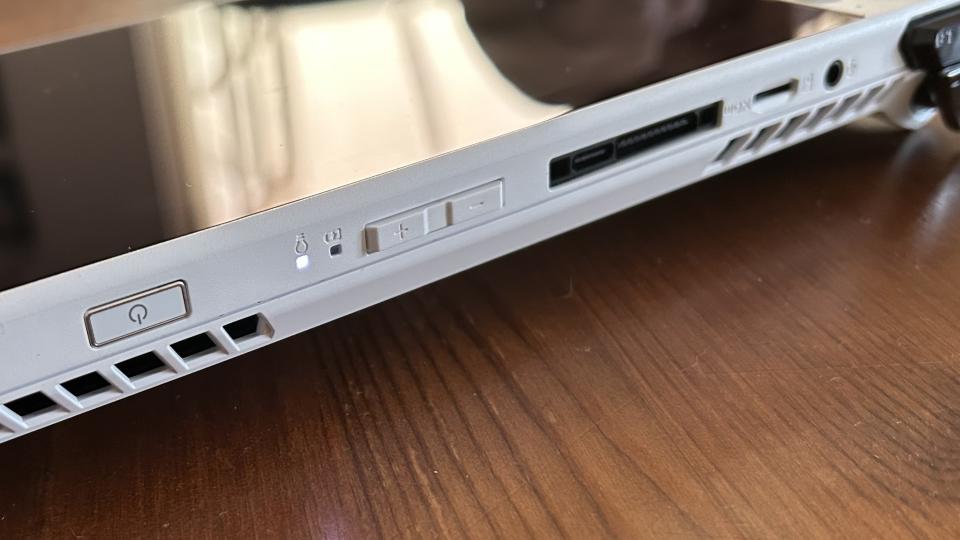
While everything is laid out well, and spaced particularly nicely to avoid accidental presses, I did find myself missing aspects of more premium-feeling controllers. This was most notable in the thumbsticks. Compared to the DualSense or even the stock Xbox Wireless controller, the sticks are a little too loose to feel truly precise here, which had an impact on quick aiming and lining up more difficult shots. This slackened feel translated into the face buttons as well, though the longer travel distance and plastic feel didn't have any impact on gameplay itself. There's not enough resistance behind these buttons to compete with more competitive options like Razer's microswitches, but they're comfortable, responsive, and offer a speedy return as well.
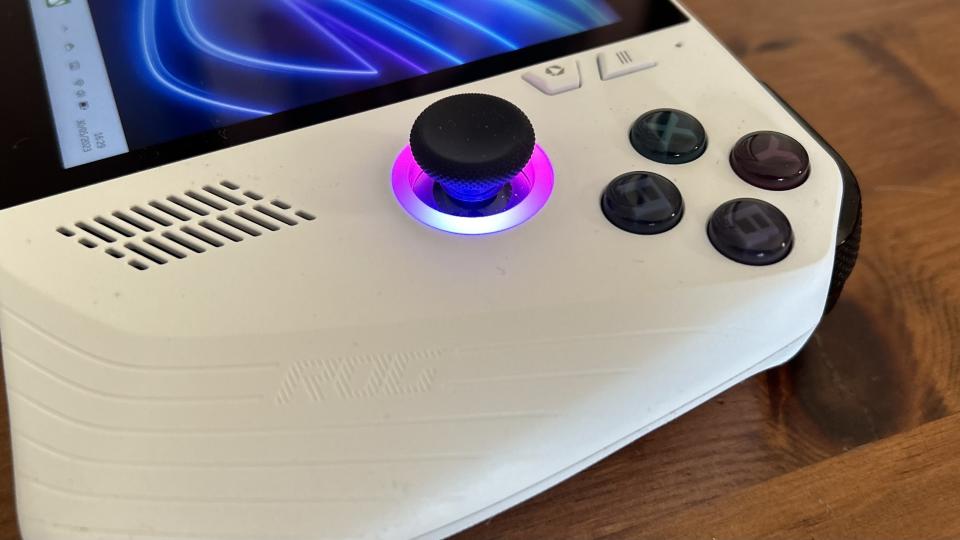
The bumpers and triggers feel great to use with a nice tactile response, just the right amount of resistance, and enough space to make twitch reactions possible. Unfortunately, the same praise can't be layered on the two programmable back buttons. Shaped somewhere in between a button and a paddle, these clickers have the opposite problem to the thumbsticks. There's just a hair too much resistance to feel truly snappy, and the smaller shape makes them less reliable in the heat of battle. There's also a hollow sound to the actuation of each of these buttons, which feels a little cheap considering the luxurious experience nearly everywhere else.
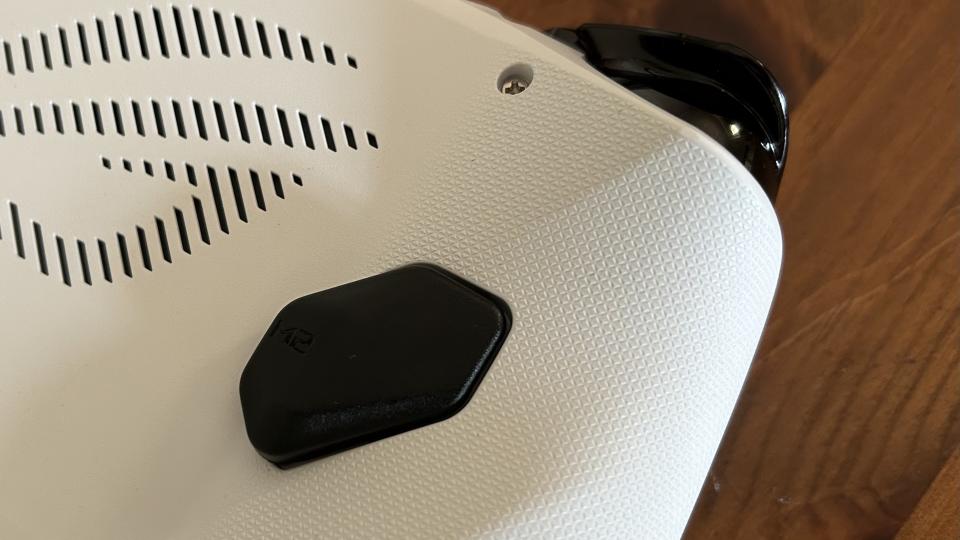
There's one omission that stands out, and it's not the lack of touchpads offered by Valve's Steam Deck. There's no Xbox button here - a staple if you're a Game Pass shortcut afficionado. It doesn't make much of a difference in everyday play, but if you're using the ROG Ally for simultaneous chat or multi-tasking you're going to struggle.
Display
1080p resolution makes for crisp viewing when it can be used
Vivid picture quality and excellent contrast
Plenty of details across the picture
All those inputs aren't going to make much of a difference if you're watching your games on a potato screen. Thankfully, the ROG Ally follows up with an excellent panel. While it's a standard LCD display, it has the vividity and color depth more comparable to that of an OLED, and boasts a higher 1080p resolution than the Steam Deck's 1280 x 800 hybrid. Running at 120Hz, this is a slick, bold, and bright display offering incredible immersion and sumptuous picture across a range of genres.
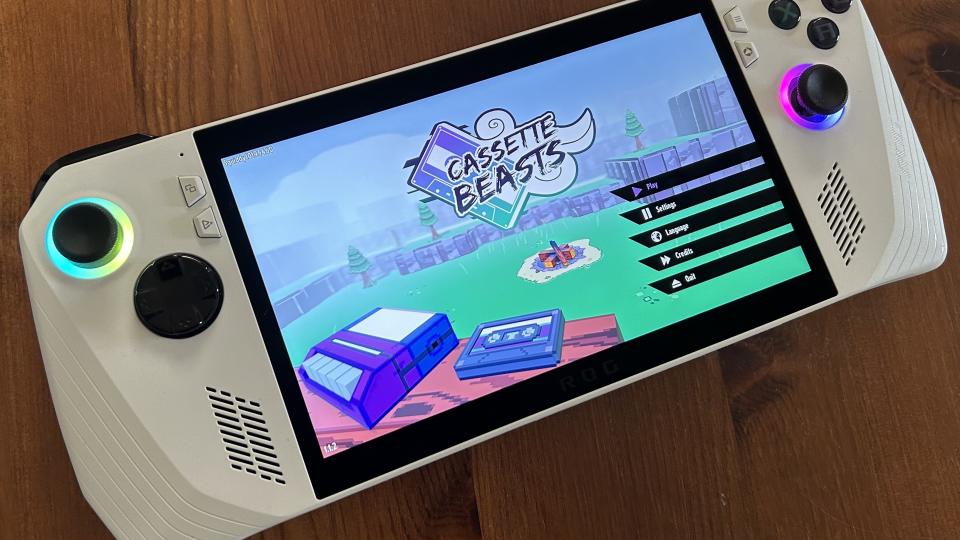
That higher resolution might not always be in play for the best graphical settings but when you've got the scope to really let it rip it absolutely shines. Cassette Beasts packs a phenomenal punch on this screen, with an energetic contrast and super crisp picture that kept up with the frenetic style of the action on screen. It doesn't quite keep up with the Switch's OLED panel when it comes to fidelity in darker scenes; Steamworld Heist was noticeably less lively, for example. However, the 120Hz refresh rate more than made up for it in my experience. Such silky smooth motion is tricky to find on a handheld, and on a screen this size it feels far faster to boot.
High on Life made particularly good use of this motion handling, but also showcased the Ally's ability to handle finer details within the picture as well. Looking out across the neon expanse of Dreg Town, I could make out far off buildings, individual asteroids, and even smaller splatters on a lower floor from atop a set of steps.
Audio
Dual front firing speakers pack plenty of power
Nice balance across ranges even in more bass-heavy environments
Surround sound is generally accurate but sometimes over-emphasized
I'm grateful the Asus ROG Ally can back up a screen as immersive as this with a powerful set of lungs. Dual front firing speakers blast audio with clarity and gumption, balancing ranges with a delicate hand and still managing to pack a punch when needed. Atomic Heart's KS-23 shotgun ricocheted around my living room with every shot, rumbling through the low end without distorting the background sound. There was a nice amount of impact to environmental audio, with dialogue being particularly well represented in crisp, clear tones.
The Ally also boasts virtual Dolby Atmos 5.1.2 channel surround sound, offering a nice sense of direction across more competitive shooters. I did sometimes find this enhanced audio a little over-emphasized, though. The moment I moved my camera in High on Life, the audio seemed to shift wildly to the size, disproportionately to the actual angle of view. Yes, this is in close quarters dialogue situations more than anything else, and that emphasis can come in handy in combat situations. However, it's not an issue I've experienced with gaming headsets offering similar features.
Software
Windows 11 presents navigation issues
Armoury Crate makes for a more console-like experience...
... but is still held back by Windows
The Asus ROG Ally's hardware is impressive, but it's obvious Windows 11 needs a dedicated gaming mode. You're getting the full Windows operating system here, and the vast majority of it isn't needed, while everyday control, typing and navigating suffers for it. The Ally does present you with a keyboard for typing inputs when it feels like it (I was strangely stuck on various different text boxes where the onscreen keys simply didn't appear, across web browsing and different launchers), but requires use of the touchscreen to use it. Scrolling is hit and miss depending on the program being used; Steam automatically boots in Big Picture mode which is silky smooth, but others like Epic or Chrome will scroll slightly before jumping down the page when using the thumbstick. You can control a cursor with this stick, but it's so wildly sensitive it's pretty much impossible to get anything done.
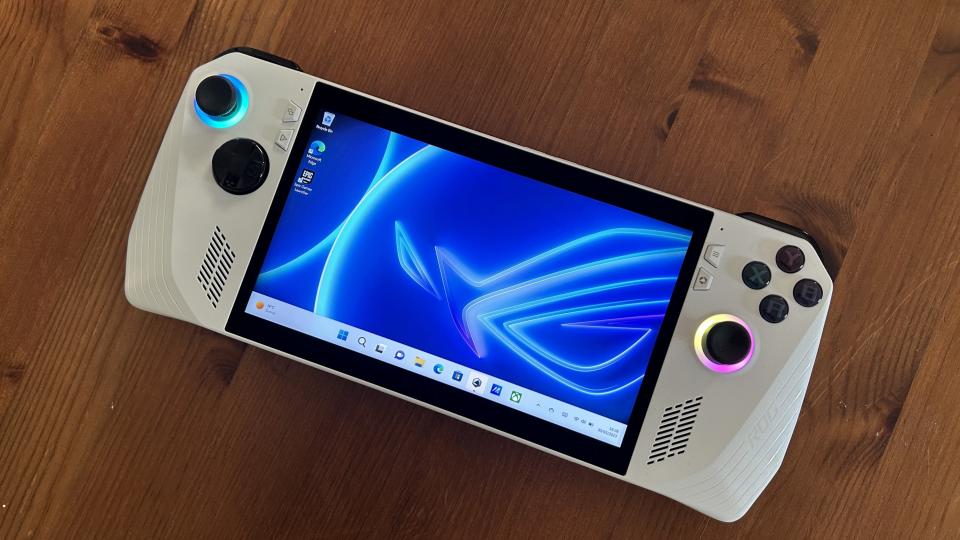
It's technically possible (system settings and browser downloads aside) to use the Asus ROG Ally primarily from its Armoury Crate software, though. This is where I initially predicted one of the biggest everyday use improvements over the Steam Deck when the Ally was first launched and, like most predictions, there's a pinch of salt to be taken. Yes, being able to see every game downloaded onto the system in one clear menu, regardless of the launcher it uses, is a bonus. It's a much more console-like experience that streamlined everything about how I played on PC during my testing. However, there are smaller quality of life features that I hadn't considered before diving in.
You can't, for example, pause and resume a game from this launcher like you can on Steam Deck. This is, after all, a PC - and you'll be quitting and reloading like you do every day on a PC. Just hitting the power button to send the system to sleep before resuming later on didn't work out too well for me either. Every time, no matter the game, I would load back in to a broken mess of a game, with almost no framerate to speak of, years of input lag, and crackly audio. It's just too much to ask of Windows at the moment.
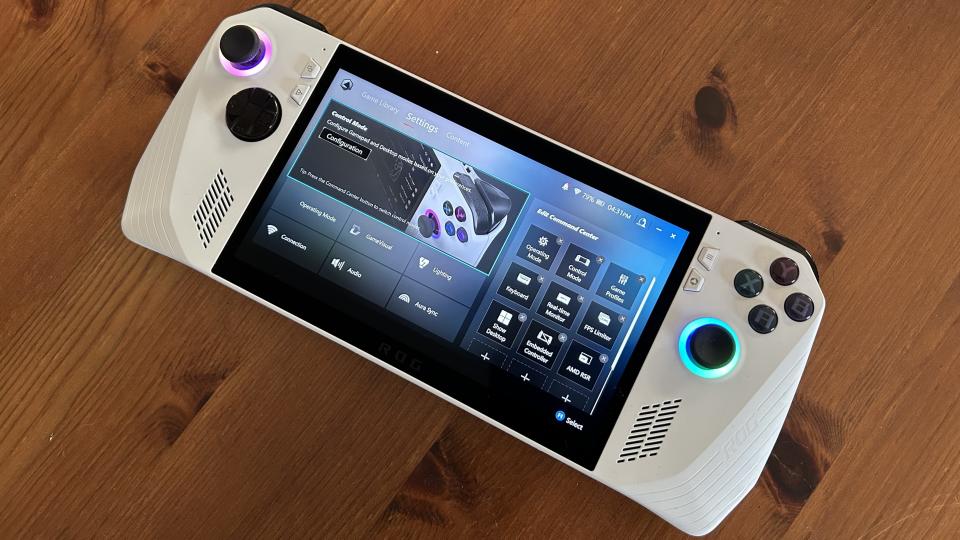
Armoury Crate is more than a launcher, though. It also houses control mapping for Desktop Mode and Gamepad Mode (two of the three control schemes that the software applies to each game you play), power presets, display settings, RGB assignments, and gives you space to edit the Command Center overlay available in-game.
Compatibility
Technically compatible with any Windows game
Dock with charger or external GPU for keyboard and mouse
Only one USB-C port which will likely be used for power
A Windows operating system means pretty much every game you can download onto a PC will be playable on Asus ROG Ally. It might not run well, but it will run. The control scheme and lack of touchpads means titles designed for a keyboard and mouse certainly don't run well, especially due to that over-zealous cursor. Of course, there are plenty of gadgets compatible with the ROG Ally to help you out.
The official charger dock, for example, allows for an HDMI connection up to a separate monitor with USB slots for a keyboard and mouse. Or, you can go the whole hog and hook up your handheld to the ROG XG Mobile, a dedicated eGPU ready to whack an RTX 4090 or AMD graphics card into your setup.
Audio compatibility is a slightly trickier issue in handheld mode. There's only one USB-C port here, and - as we'll see in the battery section - it will likely be filled by your power cable. That means you're going to be relying on a Bluetooth headset rather than the 2.4GHz connections which require a free port. Thankfully today's best gaming earbuds can keep up with the speeds required for everyday play, but more competitive players might find themselves lagging.
Performance
1080p now smooth with updates
Demanding games can average around 60fps with graphical tweaks
Power presets make a big difference
I have to head up the performance category with a note as to why this review is a little later than usual. The original ROG Ally device I received required additional updates and fixes to run, with very low framerates, crazy input lag, frequent crashes, strange Windows UI errors, and a Steam Big Picture mode that kept hiding the menu from me. I couldn't even get past the title screen of Borderlands The Pre-Sequel, and that game's nearly 10 years old.
Since Asus worked its magic with my review unit, though, things have turned around. Obviously this original device contained some errors which could be fixed with a BIOS update, though whether or not some retail units could ship with similar faults is another issue. Once everything was polished up, I was flying through menus and enjoying fluid gameplay across far more demanding titles.
AMD's Ryzen Z1 Extreme processor and Radeon RDNA 3 graphics make for a powerful set of specs in this handheld arena. That CPU boasts eight cores and 16 threads, offering an immense amount of power, especially when side by side with the Steam Deck's AMD Zen 2 APU. It's easy to see why Asus has had to beef up the internals here, and that's largely down to the 1080p resolution on offer.
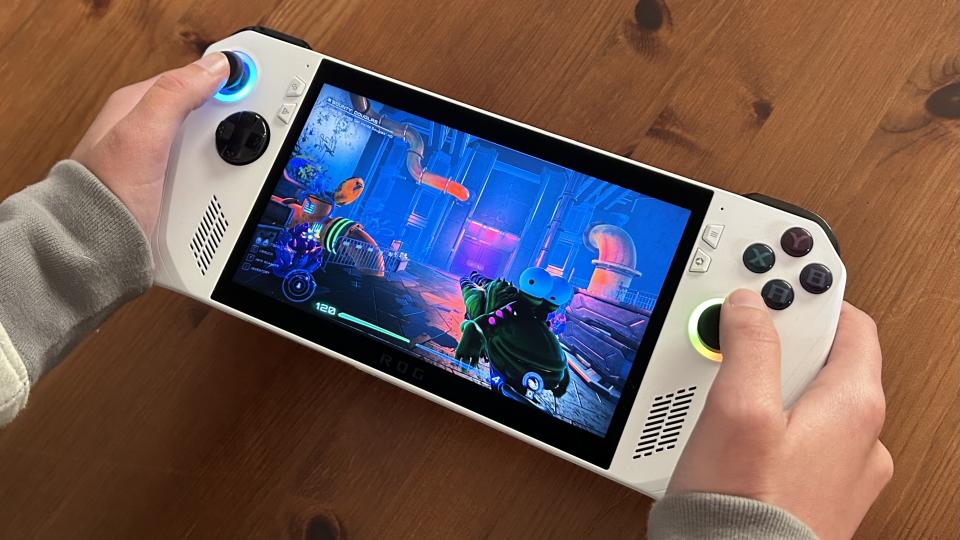
I did notice a significant drop in framerates across Doom Eternal, High on Life, and Atomic Heart when bumping resolution up, but could smooth things out with some graphical tweaks. Those looking for fluid action will likely need to stick close to 720p here. I managed to keep framerates at between 60 and 70fps in Doom Eternal, which ultimately dropped down to around 30fps in 1080p. Similarly, I was netting around 65fps on average in High on Life before dropping to the 40s with a bumped resolution. Neither scenario is unplayable, but there were far more stutters and jumps when that screen was working its best. Of course, less demanding titles were far easier on the system. Ghost song was blitzing at around 100fps, for example.
You will need to play around with graphics settings and power presets here. I was never experiencing truly fluid gameplay more demanding games outside of Turbo mode and at Ultra settings. Instead you could find me closer to Medium and High with a few extra tweaks on shadows and textures. In a world where I'm using the Asus ROG Ally as a secondary PC for on the go play, though, I'm satisfied with where we are right now.
Battery
Unfortunately, if you're planning on using the Asus ROG Ally on the go for more than a couple of hours you're likely to be disappointed. Asus let the Ally out the gate with a promise of an 8 hour battery life - that doesn't mean game-time battery life. I was averaging closer to two hours on the default performance settings, and an hour to an hour and a half on Turbo across my tested titles. That's disappointing for sure, but doesn't stray too far from Steam Deck's own battery.
Should you buy the Asus ROG Ally?
When all is said and done the Asus ROG Ally is a remarkable piece of kit. Anyone looking for a handheld Game Pass machine under four figures should be seriously considering this new contender. The display, form factor, and general performance are well worth an early adopter's investment, especially if you're going to make the most of as wide a library as Xbox's. I'd also recommend the Ally to anyone looking for a Nintendo Switch alternative, as long as you're happy with the fiddly Windows operating system for the benefit of a far wider range of games. When it comes to the main debate, though, Asus ROG Ally vs Steam Deck, things aren't as clear cut.
The Steam Deck benefits greatly from those touch panels and by using its own Steam OS. The general navigation and quality of life experience is vastly improved here, even if you do need to spend more time booting up Epic or Game Pass. I would, however, argue the form factor and comfort of the Ally could sway even those ready and willing to dual-boot into Windows on Valve's model.
That said, the extra power under the hood is swamped by the Windows 11 operating system and 1080p resolution, rendering its impressive spec sheet moot. Add in the fact that Windows isn't built as a console-like gaming platform and struggles to integrate itself into this use-case, and it's clear the Asus ROG Ally is - currently - ahead of its time. I've been having too much fun with this first iteration to not recommend it, but the best is yet to come and the majority of players may want to wait for it.
How we tested the Asus ROG Ally
I tested the Asus ROG Ally in two stints, the first for three days before returning the unit for vital updates and the second for just over a week. This review is written based on the experiences of my second encounter with the Ally, with findings from the first included where applicable. During this time, I primarily tested across High on Life, Cassette Beasts, Atomic Heart and Ghost Song while also performing stress tests across Apex Legends and Doom Eternal.
For more portable kit, check out the best gaming tablets and the best gaming phones on the market. We're also rounding up all the best mobile controllers to boot.
